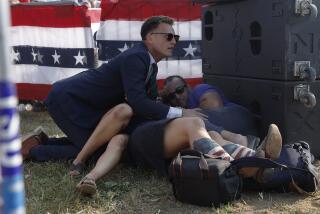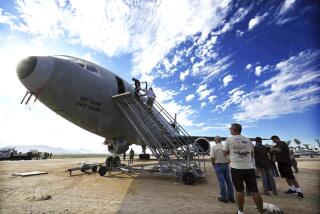In-Flight Wish List: Firearms, Tasers
- Share via
WASHINGTON — American Airlines Capt. Linda Pauwels is an “anti-gun” mom who keeps her two young children away from violent video games and television shows.
Yet if the government allows pilots to pack a pistol to defend the cockpit against hijackers, Pauwels said she’ll get a gun and explain to the kids that she needs it for work.
Flight attendant Alin Boswell always prided himself on keeping the customers happy. Now he worries a customer could turn out to be a terrorist he’d have to battle at 30,000 feet.
“You look at everything, from wine bottles to oxygen bottles to fire extinguishers--anything you can use to protect yourself,” Boswell said. Ideally, he said, he’d like a stun gun, which fires electrically charged darts to temporarily immobilize an attacker.
Five months after the Sept. 11 attacks, pilots and flight attendants complain they have yet to receive any meaningful self-defense training, though their jobs now require them to take down anyone from a shoe bomber to a business traveler who suddenly decides to kick in the cockpit door.
This week, the government begins formal consideration of demands from flight crews for a new kind of standard-issue equipment: The pilots want semiautomatics, while the flight attendants say stun guns would be a wiser option for both. More than 6,000 people have responded to a Federal Aviation Administration request for public comments, and the vast majority support arming crews--with firearms.
But airlines adamantly oppose firearms, and some Transportation Department officials fear any kind of weaponry will lead to unintended consequences. “This is not something that is a slam dunk,” said one official, referring to firearms. “As for Tasers [stun guns], I’m not sure how one trains for it, but don’t volunteer me.”
While the government deliberates, pilots and flight attendants wrestle with anxiety and a lingering sense of vulnerability. The stepped-up security at airports offers little reassurance, they say. Instead, it often adds unneeded hassles.
Even with uniforms and airline ID, crew members are subject to metal detection wands, shoe checks, pat-downs and hand searches of their bags, though workers who service planes on the ground do not have to endure such rigors.
“The whole thing doesn’t make any sense,” said Pauwels, who lives in Mission Viejo and flies MD 80 jetliners out of Los Angeles International Airport. “I have had my personal hygiene products removed from my bag and looked at. That is very embarrassing. It’s difficult when you’re doing this job to be treated as if you’re part of the problem, not the solution.”
“Going to work is just like getting flogged,” said another airline pilot, who asked not to be identified because his company discourages media interviews. “I go through security and I just have to bite my tongue, because I don’t want to say anything that might get me arrested.”
On a certain level, the push by pilots to be armed is about repairing psychological damage. Their proudly autonomous profession was grossly violated by the events of Sept. 11, and now they endure a thousand perceived affronts, such as the confiscation of pocket tools they routinely carried for small emergencies.
“People don’t understand what we mean when we say ‘Arm the pilots,’ ” said Capt. Steve Luckey, the leading security expert for the Air Line Pilots Assn. “Just giving the pilot a gun would be a very irresponsible approach. We’re talking about a program that would be built with the help of the FBI. These would be armed federal officers, who happen to be recruited from pilot ranks.” The volunteer pilots would augment the ranks of federal air marshals.
The idea has gut-level appeal, critics say, but it is also fraught with problems. A gunfight at cruising altitude could damage the aircraft or lead to a loss of control. And what if a deputized pilot shot a frequent flier by mistake? Would the pilot go to jail? Would the airline be liable?
“It makes far more sense to armor the cockpit door against small arms fire and blast forces than to arm pilots with a lethal weapon,” said Douglas Laird, a former Secret Service agent and former security director for Northwest Airlines. “The role of the pilot in any crisis is to get the plane on the ground. That in itself is a challenge, and you don’t need to divert their attention.”
Pilots respond that they would draw their guns only under very limited circumstances--if there was no other way of stopping an intruder who broke into the cockpit. Just last week, a co-pilot on a Miami-to-Buenos Aires flight used the blunt end of an emergency ax to clobber a man who tried to get in the cockpit. What if that man had been armed?
“Barriers are broken and security systems fail,” said Pauwels, who is also an official spokeswoman for the Allied Pilots Assn. “If there is more than one person who wants to wreak havoc, it’s possible that they may be able to penetrate the cockpit barrier. If these people knew that you were armed, that would change things.”
In polls, more than 80% of pilots say they want weapons, and about the same proportion of the general public agrees. Yet the minority of pilots who disagree raise well-considered objections.
“The odds of a pilot using a firearm in the ultimate scenario are infinitesimal compared with the odds of having an embarrassing incident,” said a Boeing 737 pilot who requested anonymity. “The potential damage to the profession outweighs the benefit.”
Flight attendants are also at odds with pilots over firearms. “We don’t think it’s the best idea for the pilots,” said Dawn Deeks, a spokeswoman for the Assn. of Flight Attendants. Yet the flight attendants want stun guns for themselves.
“We have been told repeatedly by our pilots that we are on our own,” said Boswell, a flight attendant for 13 years. “We could be screaming and getting killed, and they are not going to open that cockpit door. We’re on the other side of the door, and we’re the ones who need the help.”
Boswell lives in the Washington suburbs and drives by the Pentagon on his way to work at Ronald Reagan National Airport. On Sept. 11, he was aboard a transcontinental flight and found out what happened only after his plane was ordered to land.
“There has just been a whole shift in the mind-set of the crews since then,” he said. “If you think you’re going to take my plane, it’s pretty much going to have to be over my dead body.”
But he wants a fighting chance. “I want something that would incapacitate a person,” Boswell said. “I don’t want to take a person out permanently, but I want to be able to get the situation under control.”
Whether stun guns could be used to restore control--or whether they would create more opportunities for chaos--remains to be seen. The Justice Department is soon expected to deliver a technical report on the issue to the new federal Transportation Security Administration. Among the unanswered questions: How effective are stun guns? Could they be safely stowed on board? Is there a foolproof way to guarantee that flight attendants could access the weapons in an emergency? What if a terrorist--or merely an unruly passenger--got hold of a Taser? What if someone takes a blast and keeps charging?
Some airlines are already on record as favoring stun guns. “We support the Taser,” said Joe Hopkins, a spokesman for United Airlines. “We feel that they would be effective, and we have done our own testing that indicates that. One advantage is that it’s not going to penetrate the skin of the aircraft.”
The government has set no deadline for a decision on stun guns or firearms. Meanwhile, the FAA is counseling pilots and flight attendants to be patient. The agency has issued new guidelines for anti-hijacking training, and spokesman Les Dorr said most flight crew members will be retrained by the end of the year.
The new training will provide the latest survival skills and strategies for various crisis scenarios. “This is going to be developed by the FBI,” Dorr said. “The prime consideration is to get the airplane on the ground as soon as possible to prevent it from being commandeered and used as a weapon of mass destruction.”
Pauwels said that assurance is not enough for her. She’s not sure she can ever let down her guard again. “Let’s say that we are successful and we don’t see any more events like those of Sept. 11,” Pauwels said. “Some of us might stop paying attention. We might get careless. If the pilots were armed, at least we’d have that last line of defense always there.”
More to Read
Sign up for The Wild
We’ll help you find the best places to hike, bike and run, as well as the perfect silent spots for meditation and yoga.
You may occasionally receive promotional content from the Los Angeles Times.






